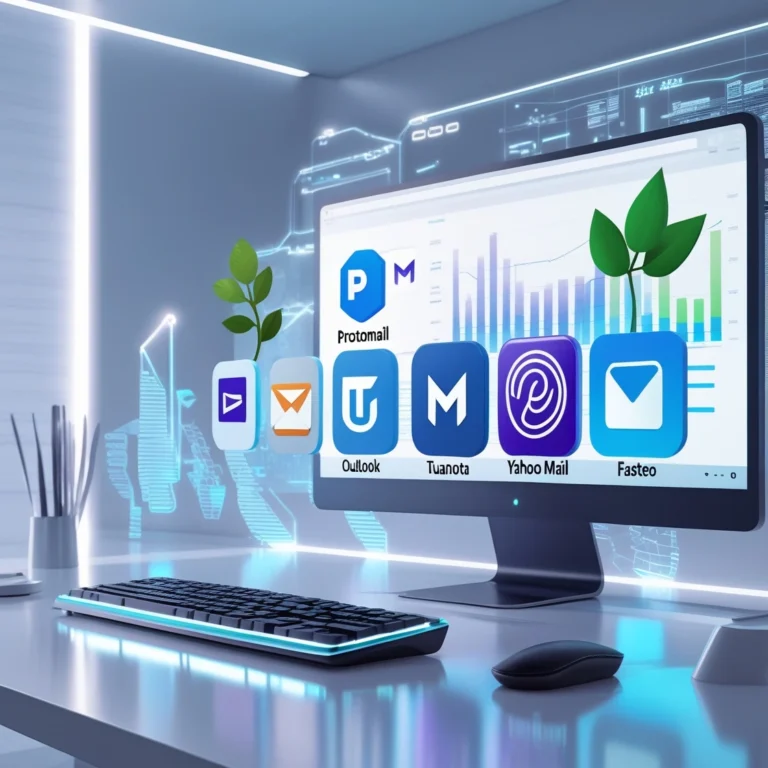Your Guide to Top Tech Trends for Businesses in 2025
Navigating the Digital Frontier: Top Tech Trends Reshaping Businesses in 2025
Estimated reading time: Approximately 20 minutes
Key Takeaways
- AI integration across web, mobile, and business automation is fundamentally transforming operations and user experiences.
- Performance optimization (Next.js, React, Flutter) and scalable architectures (serverless, microservices, headless CMS) are crucial for competitive digital presence.
- Cloud computing, DevOps, and strategic digital transformation are foundational for achieving agility, resilience, and efficiency in modern businesses.
- User-centric UI/UX design, emphasizing intuition, accessibility, and immersion, is paramount for successful digital products.
- AITechScope specializes in AI-powered automation, n8n workflow development, and business process optimization to help companies scale, reduce costs, and innovate effectively.
Table of Contents
- Introduction: The Unstoppable March of Innovation Towards 2025
- The Evolution of Web Development in 2025: Smarter, Faster, More Flexible
- Mobile App Development in 2025: Innovation at Your Fingertips
- Cloud Computing and DevOps: The Backbone of Modern Digital Operations
- AI Automation for Businesses: Driving Efficiency and Innovation
- Modern UI/UX Design: Crafting Seamless User Experiences
- Digital Transformation Strategies for Growth in 2025
- AITechScope: Your Partner in Digital Evolution
- Frequently Asked Questions (FAQs)
- Conclusion: Embracing the Future of Technology
Introduction: The Unstoppable March of Innovation Towards 2025
The digital world is a relentless current, constantly reshaping industries, transforming how businesses operate, and redefining user expectations. As we approach 2025, the pace of technological advancement is not merely accelerating; it’s undergoing a profound evolution, driven by unprecedented integration of artificial intelligence, sophisticated cloud infrastructure, and increasingly human-centric design. For business owners, developers, and tech enthusiasts alike, understanding these pivotal shifts is not just an advantage—it’s a necessity for survival and growth.
This comprehensive guide serves as your playbook for 2025, delving deep into the most impactful tech trends across various domains. We will explore the cutting-edge of web development, from AI-powered applications to the intricacies of Next.js and React performance. We’ll navigate the dynamic landscape of mobile app innovation, examining the Flutter vs. React Native debate and the rise of AI-driven mobile experiences. Our journey will also encompass the robust foundations of cloud computing and DevOps, including the efficiency of serverless architecture and the power of CI/CD automation. A significant focus will be placed on the transformative potential of AI automation for businesses, showcasing how intelligent systems are streamlining operations and fostering innovation. Finally, we’ll dissect the principles of modern UI/UX design, emphasizing intuitive and accessible user experiences.
At AITechScope, we stand at the forefront of this digital revolution, specializing in AI-powered automation, n8n workflow development, and business process optimization. Our mission is to empower businesses to leverage these cutting-edge AI tools and technologies, enabling them to scale operations, significantly reduce costs, and dramatically improve efficiency through intelligent delegation and advanced automation solutions. Join us as we uncover how today’s tech can not only accelerate growth and improve performance but fundamentally transform the way companies operate, setting the stage for an era of unprecedented digital innovation.
The Evolution of Web Development in 2025: Smarter, Faster, More Flexible
Web development is no longer just about building websites; it’s about crafting intelligent, responsive, and highly personalized digital experiences. In 2025, the landscape is defined by a blend of AI integration, performance obsession, and architectural flexibility. Businesses that embrace these 2025 web development trends will gain a significant competitive edge.
AI-Powered Web Apps: The New Standard
The era of static, one-size-fits-all web experiences is rapidly fading. In 2025, AI-powered web apps are becoming the new standard, integrating artificial intelligence directly into both front-end and back-end processes. This integration fuels:
- Personalization at Scale: AI algorithms analyze user behavior in real-time to deliver highly personalized content, product recommendations, and user interfaces. Imagine an e-commerce site that dynamically reconfigures its layout and product suggestions based on a user’s browsing history, demographics, and even emotional cues detected through their interactions.
- Automated Content Generation and Curation: Generative AI tools are now capable of assisting with everything from drafting marketing copy and blog posts to suggesting design elements and even generating entire web components. This speeds up content pipelines and ensures relevance.
- Enhanced User Experience: AI drives intelligent chatbots for customer service, predictive search functionalities, and adaptive interfaces that learn user preferences over time. These features contribute to a smoother, more intuitive interaction, making AI chatbots for customer service a crucial component of modern web applications.
- Operational Efficiency: Beyond the user, AI assists developers with code generation, bug detection, and automated testing, streamlining development workflows.
Companies looking to “make their SaaS smarter” are exploring “3 Low-Effort AI Features That Delight Users,” such as intelligent search, personalized dashboards, and automated summary generation, showcasing how even subtle AI integrations can significantly enhance user satisfaction and business value.
Next.js and React Performance: Building Blazing-Fast Experiences
In a world where attention spans are measured in milliseconds, website speed is paramount. Google’s Core Web Vitals have cemented performance as a critical factor for SEO and user satisfaction. This makes Next.js and React performance a top priority for web developers in 2025.
React continues its dominance as a leading JavaScript library for building user interfaces, while Next.js has emerged as its powerhouse framework, particularly for server-rendered React applications. Next.js offers crucial features like:
- Server-Side Rendering (SSR) and Static Site Generation (SSG): These rendering techniques ensure that users receive fully formed HTML pages instantly, drastically improving initial load times and boosting SEO.
- Automatic Code Splitting: Only the necessary JavaScript code is loaded for each page, reducing the overall bundle size and speeding up page interactions.
- Image Optimization: Built-in features automatically optimize images, ensuring they are delivered in the most efficient format and size.
For small businesses, Next.js for small business sites represents a game-changer. It enables them to “build a fast marketing site in one weekend” that rivals the performance of enterprise-level applications. This focus on speed is not just about user satisfaction; it directly impacts conversion rates and search engine rankings. A “Real-World Case Study: How We Cut Page Load by 60% for a Client” often highlights the immense business benefits of such performance optimizations. Developers are increasingly employing “5 Simple React Performance Fixes That Reduce Page Load by Seconds,” including memoization, lazy loading components, and optimizing re-renders, to deliver unparalleled speed.
Headless CMS and WordPress: Flexible Content Architectures
The demand for multi-channel content delivery—websites, mobile apps, smart displays, voice assistants—has propelled the headless CMS architecture into prominence. In 2025, businesses are detaching their content management from their presentation layer, offering unprecedented flexibility.
- Understanding Headless CMS: Unlike traditional CMS platforms where content and presentation are tightly coupled, a headless CMS provides content through APIs, allowing developers to use any front-end technology (like Next.js or React) to display it.
- WordPress Without the Bloat: While WordPress remains a dominant CMS, many are leveraging it in a headless fashion. This means using WordPress solely for content creation and management, then connecting it to a modern, fast front-end framework. This approach combines WordPress’s user-friendliness for content editors with the performance and scalability of modern JavaScript frameworks. Developers are seeking “WordPress without the bloat: lightweight plugins that actually help SEO” to ensure their headless WordPress backend is as efficient as their cutting-edge front-end.
- Benefits: This architectural shift offers superior flexibility, allowing businesses to push content to diverse platforms simultaneously, enhance scalability, and future-proof their digital presence by easily swapping out front-end technologies without disrupting content. It’s a cornerstone for agile content strategies and supports complex digital transformation strategies.
Micro Frontends: Scalability for Complex Web Applications
As web applications grow in complexity, managing them as monolithic entities becomes increasingly challenging. Micro frontends offer a solution by applying the principles of microservices to the front-end development, breaking down a large application into smaller, independently deployable units.
- When They Help and When They Hurt (Practical Examples): Micro frontends shine in large organizations with multiple independent teams working on different parts of a single application (e.g., a complex e-commerce platform with separate teams for product listings, cart, and checkout). They promote team autonomy, allow for technology diversity (different teams can use different frameworks), and simplify deployment.
- Challenges: However, they introduce overhead in terms of infrastructure, communication between micro frontends, and ensuring a consistent user experience. They are not a one-size-fits-all solution but are crucial for enterprise digital adoption strategies involving large-scale, evolving web platforms.
- Impact on Development: This architectural pattern contributes to a modern tech stack for modern businesses, fostering agility and allowing faster iteration on specific features without impacting the entire application.
Mobile App Development in 2025: Innovation at Your Fingertips
Mobile applications continue to be the primary touchpoint for billions of users worldwide. In 2025, mobile app development is characterized by the dominance of cross-platform solutions, deep AI integration, and a relentless pursuit of intuitive and immersive user interfaces.
Cross-Platform Dominance: Flutter vs. React Native in 2025
The debate between native and cross-platform mobile development has largely shifted towards the latter, with frameworks like Flutter and React Native leading the charge. For businesses, especially startups, choosing “which mobile framework for startups” is a critical decision.
- React Native vs Flutter in 2025: Which Is Best for Your Business App?
- React Native: Backed by Meta, React Native allows developers to build mobile apps using JavaScript and React, leveraging a vast ecosystem and familiar syntax for web developers. Its “learn once, write anywhere” philosophy remains attractive. It’s excellent for apps requiring close integration with native modules and offers hot reloading for quick iterations.
- Flutter: Developed by Google, Flutter uses Dart and offers a comprehensive UI toolkit for building natively compiled applications for mobile, web, and desktop from a single codebase. Its focus on performance and a rich, customizable widget library (Material Design and Cupertino) makes it appealing for visually intensive apps and delivering a consistent UI across platforms. Flutter’s hot reload and hot restart features accelerate development significantly.
- Pros and Cons for Startups and Enterprises:
- Startups: Both offer rapid development, cost efficiency, and wider audience reach. Flutter often boasts slightly better performance and a more consistent UI out-of-the-box due to its rendering engine, making it ideal for apps where a pixel-perfect design and animation are key. React Native’s larger developer community and ability to reuse web components can be a draw for startups already invested in the React ecosystem. Building a “simple cross-platform app with Flutter: From Idea to Play Store” can be incredibly fast.
- Enterprises: Both frameworks support complex applications. Enterprises might lean towards React Native if they have existing JavaScript/React expertise and a need for deep native module integration. Flutter might be chosen for its strong performance, consistent UI, and Google’s backing for long-term stability. The choice often comes down to existing team skillsets and specific app requirements.
AI Integration in Mobile Apps
Just like web applications, mobile apps are becoming smarter through AI. In 2025, AI is not just a feature but an integral layer of the mobile experience.
- Personalized Experiences: AI powers adaptive UIs, content recommendations, and dynamic feature sets based on user behavior, location, and context.
- Predictive Analytics: Mobile apps use AI to anticipate user needs, from suggesting the next action in a productivity app to predicting purchase intent in retail.
- Voice and Conversational Interfaces: Beyond basic voice commands, AI enables sophisticated conversational UIs, making apps more accessible and hands-free. This includes implications for emerging devices like AI smart glasses, where voice becomes a primary interaction method.
- On-Device AI: Advancements in mobile chipsets allow for more AI processing directly on the device, enhancing speed, privacy, and offline capabilities. This is crucial for privacy-sensitive applications and for reducing reliance on cloud infrastructure.
Mobile App UI Trends: Intuitive and Immersive Experiences
User Interface (UI) and User Experience (UX) remain critical for mobile app success. In 2025, the focus is on creating responsive UI design that is not only aesthetically pleasing but also highly intuitive, accessible, and immersive.
- Seamless Responsiveness: Apps must adapt flawlessly across a multitude of device sizes and orientations, from smartphones to foldables and tablets.
- Dark Mode and Dynamic Themes: These are no longer niche features but expected options, improving user comfort and battery life.
- Gesture-Based Navigation: Increasingly sophisticated and customizable gesture controls reduce clutter and enhance the feeling of direct manipulation.
- Haptic Feedback: Subtle vibrations provide tactile confirmation for actions, adding a layer of immersion and intuitiveness.
- Focus on Accessibility: Designing for all users is paramount. This includes features like larger text options, high-contrast modes, and thoughtful implementation of assistive technologies. Learning from guides like “Designing Accessible Buttons: A Non-Designer’s Guide (Figma Tips)” is becoming standard practice, ensuring interfaces are usable by everyone.
Wearable Tech & Beyond: The Rise of AI Smart Glasses
Beyond traditional smartphones, the mobile experience is extending into wearable technology. A significant development for 2025 is the emergence of AI smart glasses, which promise to fundamentally alter how we interact with digital information and the world around us.
- “Always On” AI: Startups are launching devices like smart glasses with an “always-on” microphone, capable of listening and recording every conversation. This integration raises profound questions about privacy, data security, and the ethics of constant surveillance versus the potential for groundbreaking utility.
- Augmented Reality (AR) Integration: These glasses offer the potential for seamless AR overlays, providing contextual information, navigation cues, and hands-free digital interactions directly within our field of vision.
- Real-World Implications: While the privacy concerns are significant, the potential for these devices in various fields—from assisting workers with complex tasks to enhancing personal safety (e.g., through real-time information access)—is undeniable. This trend underscores the evolving nature of software development 2025, where applications extend beyond screens into our physical environment.
Cloud Computing and DevOps: The Backbone of Modern Digital Operations
The agility, scalability, and resilience of modern businesses are directly tied to their cloud infrastructure and streamlined development practices. In 2025, cloud computing and DevOps continue to evolve, with serverless architectures, robust CI/CD pipelines, and sophisticated cloud migration strategies at the forefront.
Serverless Architecture: Efficiency and Scalability
Serverless architecture represents a paradigm shift in how applications are built and deployed, abstracting away the underlying infrastructure management. Developers can focus purely on code, while cloud providers automatically handle scaling, provisioning, and patching.
- Benefits:
- Reduced Operational Overhead: No servers to manage, patch, or scale. This significantly reduces the burden on IT teams.
- Cost Efficiency: You only pay for the compute time your functions actually use, making it incredibly cost-effective for applications with variable traffic patterns (a “serverless AWS cost example” often shows dramatic savings compared to provisioned servers).
- Automatic Scalability: Serverless functions automatically scale up and down to handle any workload, ensuring high availability and performance even during peak demand.
- Ideal for Startups: For startups, a “serverless backend for startups” is an attractive option, allowing them to rapidly deploy applications without significant upfront infrastructure investment or the need for a large operations team. It allows them to focus resources on product development rather than infrastructure management.
- Use Cases: Serverless is excellent for APIs, webhooks, data processing, event-driven architectures, and even entire web applications. Insights from “Serverless on AWS: Create a Cost-Efficient Backend That Scales Automatically” demonstrate how businesses can build robust, scalable backends without the traditional infrastructure headaches.
DevOps Best Practices and CI/CD Automation
DevOps culture, coupled with robust automation, remains critical for accelerating software delivery and improving reliability. In 2025, DevOps best practices are deeply integrated into development cycles, with CI/CD automation being the norm.
- Continuous Integration/Continuous Delivery (CI/CD): This methodology automates the processes of building, testing, and deploying code changes.
- Continuous Integration (CI): Developers frequently merge code into a central repository, where automated builds and tests are run to detect integration issues early.
- Continuous Delivery (CD): Ensures that code changes are always in a deployable state, ready for release to production at any time.
- Continuous Deployment (CD): Takes it a step further, automatically deploying every change that passes all tests to production without manual intervention.
- CI/CD for Small Teams: These practices are not just for large enterprises. “CI/CD for Small Teams: Automated Deployments Without the Headache” highlights how even small development teams can leverage tools like GitHub Actions to achieve rapid, reliable deployments, freeing up developers to focus on innovation rather than manual release processes. A “GitHub Actions deploy tutorial” demonstrates the simplicity and power of setting up automated workflows directly from version control.
- Infrastructure as Code (IaC): Managing infrastructure through code (e.g., Terraform, CloudFormation) ensures consistency, repeatability, and version control, further solidifying DevOps principles.
Cloud Migration Strategies: Moving to the Future
Many businesses still operate with legacy applications on on-premise infrastructure. In 2025, cloud migration strategy is a crucial component of digital transformation strategies, enabling businesses to modernize their IT landscape and leverage the benefits of the cloud.
- “How to Move Your Legacy App to the Cloud Without Breaking It“: This common challenge requires a well-planned approach, often involving:
- Rehosting (Lift-and-Shift): Moving applications to the cloud with minimal changes.
- Re-platforming: Making some optimizations to take advantage of cloud features without re-architecting.
- Re-architecting: Redesigning the application to fully leverage cloud-native services (e.g., moving to microservices or serverless).
- Phased Approaches: Migrations are often executed in phases, prioritizing certain applications or components to minimize risk and disruption.
- Hybrid and Multi-Cloud Environments: Many enterprises opt for a hybrid approach (combining on-premise with cloud) or a multi-cloud strategy (using multiple cloud providers) to enhance resilience, avoid vendor lock-in, and meet specific regulatory requirements.
Microservices Architecture: Agility and Resilience
Complementing serverless and CI/CD, microservices architecture continues to gain traction as a way to build scalable, resilient, and independently deployable applications.
- Benefits:
- Scalability: Individual services can be scaled independently based on demand.
- Agility: Teams can develop, deploy, and update services independently, leading to faster development cycles.
- Technology Diversity: Different services can be written in different programming languages and use different databases, allowing teams to choose the best tool for each specific job.
- Resilience: The failure of one service is less likely to bring down the entire application.
- Challenges: Increased operational complexity, distributed data management, and the need for robust communication mechanisms between services are key considerations. Despite these, for complex, evolving applications, microservices are a fundamental component of a modern tech stack for modern businesses.
AI Automation for Businesses: Driving Efficiency and Innovation
Artificial Intelligence is no longer a futuristic concept; it’s a practical, accessible tool transforming business operations. In 2025, AI automation for businesses is moving beyond simple tasks to intelligent delegation, offering profound impacts on efficiency, cost reduction, and strategic decision-making.
Intelligent Automation and Workflow Optimization
The core promise of AI automation is to free up human potential by offloading repetitive, time-consuming tasks.
- AITechScope’s Expertise: This is where AITechScope shines. We specialize in n8n workflow development and leveraging AI to automate complex, multi-step business processes. This isn’t just about scripting; it’s about intelligent delegation—understanding context and making decisions based on predefined rules and learned patterns.
- Automating Repetitive Tasks with No-Code Tools + AI: Combining no-code platforms with AI capabilities allows businesses to “automate repetitive tasks with no-code tools + AI (save 5–10 hours/week)” without needing deep programming expertise. Examples include automated data entry, lead qualification, report generation, and customer onboarding sequences.
- Impact: By streamlining workflows, businesses can reallocate human talent to more creative, strategic, and high-value activities, leading to significant productivity gains and cost savings.
AI Chatbots for Customer Service and Workflow Automation
AI chatbots for customer service have evolved significantly, moving beyond simple FAQs to becoming intelligent virtual assistants capable of complex interactions.
- Enhanced Customer Experience: Modern chatbots can handle a wide range of customer queries, provide personalized support, process orders, and even escalate issues to human agents seamlessly. They offer 24/7 availability, reducing response times and improving customer satisfaction.
- “How Small Businesses Use Chatbots to Save Time: Real Workflows That Work“: This highlights practical applications for SMBs, such as automating appointment scheduling, answering common product questions, qualifying leads, and providing instant support.
- Internal Workflow Automation: Beyond customer-facing roles, AI chatbots are also revolutionizing internal operations, assisting employees with IT support, HR queries, expense reporting, and knowledge retrieval, acting as powerful workflow automation tools.
Generative AI and Content Creation
Generative AI is one of the most exciting and rapidly advancing fields, fundamentally changing how content is created and consumed.
- ElevenLabs and AI-Generated Audiobooks: Voice AI company ElevenLabs is making waves by allowing authors to “create and publish audiobooks on its own platform” using AI-generated narration. This democratization of audiobook production reduces costs and time, opening up new opportunities for authors and publishers. The company’s partnership with Spotify for AI-narrated audiobooks further underscores the mainstream adoption of this technology.
- Broader Applications: Generative AI is now used for:
- Marketing Content: Generating social media posts, ad copy, and blog outlines.
- Code Generation: Assisting developers by suggesting code snippets or even generating entire functions.
- Design Assets: Creating images, illustrations, and design variations.
- “Make Your SaaS Smarter: 3 Low-Effort AI Features That Delight Users“: These features often involve generative AI for personalized content summaries, smart recommendations, and dynamic user interfaces.
AI in Data Analytics and Decision Making
AI’s ability to process vast amounts of data and identify patterns is transforming business intelligence and strategic planning.
- Predictive Analytics: AI models forecast future trends, from sales figures and customer churn to potential market shifts, enabling proactive decision-making.
- Anomaly Detection: AI can quickly identify unusual patterns in data, crucial for fraud detection, cybersecurity, and monitoring system health.
- Business Intelligence: AI-powered tools provide deeper insights from complex datasets, translating raw data into actionable intelligence for improved operational efficiency and strategic growth.
- Ethical AI and Responsible Deployment: As AI becomes more pervasive, ensuring ethical guidelines for data usage, algorithmic fairness, and transparency in decision-making is paramount.
AI for Smart Cities and Safety
AI’s impact extends beyond traditional business applications, contributing to public safety and urban management.
- Obvio’s Stop Sign Cameras: A startup like Obvio is using AI-powered cameras at stop signs to “root out unsafe drivers,” addressing the critical issue of pedestrian safety. This application of computer vision and AI demonstrates how technology can contribute to creating safer communities without necessarily creating a “panopticon” as claimed by the founders.
- Broader Applications: AI is being deployed in smart cities for traffic management, waste optimization, public transport efficiency, and environmental monitoring, showcasing digital innovation for startups and public sector partnerships.
Modern UI/UX Design: Crafting Seamless User Experiences
In 2025, exceptional UI/UX design is not just about aesthetics; it’s about creating profoundly intuitive, accessible, and emotionally resonant digital experiences. The focus has shifted to user-centricity, performance, and ethical design.
User-Centric Design Principles for 2025
At the heart of modern UI/UX is a deep understanding and empathy for the user.
- Empathy and Inclusivity: Designers are increasingly focused on understanding diverse user needs and contexts, ensuring products are usable and enjoyable by everyone.
- Accessibility First: Responsive UI design inherently includes accessibility. “Designing Accessible Buttons: A Non-Designer’s Guide (Figma Tips)” is just one example of the detailed focus on making digital interfaces usable for individuals with disabilities. This isn’t an afterthought but an integral part of the design process, leveraging principles like sufficient contrast, proper semantic markup, and keyboard navigation.
- Personalization: As discussed with AI, UIs are becoming more dynamic, adapting to individual user preferences and behaviors to provide a tailored experience.
Immersive and Intuitive Interfaces
The boundaries of traditional screen-based interaction are expanding.
- Voice UI (VUI) and Gesture Control: These modes of interaction are becoming more sophisticated, offering natural and hands-free ways to engage with applications, particularly relevant with the rise of smart speakers and AI smart glasses.
- Augmented Reality (AR) Elements: AR overlays are increasingly integrated into mobile apps and web experiences, offering immersive product visualization, interactive guides, and enriched real-world interactions.
- Adaptive and Contextual UIs: Interfaces are designed to respond to the user’s environment, time of day, and current activity, providing relevant information and functionality without overwhelming them.
Performance as a Design Feature
User experience is inextricably linked to performance. A beautifully designed interface loses its appeal if it’s slow or unresponsive.
- Impact of Load Times: “Real-World Case Study: How We Cut Page Load by 60% for a Client” demonstrates that tangible business benefits (like increased conversions and reduced bounce rates) directly result from performance optimizations. Designers must advocate for speed and fluidity from the initial stages of a project.
- Collaborative Efforts: The best UI/UX emerges from close collaboration between designers and developers. Designers need to understand the technical implications of their choices, while developers must prioritize the user experience when implementing features and optimizing performance. This interdisciplinary approach is crucial for modern software development 2025.
Digital Transformation Strategies for Growth in 2025
Digital transformation is not a one-time project but a continuous journey of adapting to technological advancements to improve efficiency, customer experience, and business models. In 2025, strategic implementation of emerging tech is key for both large enterprises and nimble startups.
Enterprise Digital Adoption and Innovation
For large organizations, enterprise digital adoption requires a holistic approach, integrating new technologies across all departments and processes.
- Strategic Planning: This involves identifying key areas for innovation, investing in robust cloud infrastructure, and fostering a culture of continuous learning and adaptation.
- Redefining Business Models: Digital transformation often leads to the creation of new products, services, and revenue streams, leveraging data and AI to gain competitive advantage.
- Overcoming Legacy Systems: A significant challenge is integrating or replacing legacy systems, often through phased cloud migration strategies and the adoption of modern architectures like microservices.
Tech Innovation for Small Businesses and Startups
Small businesses and startups, often with limited budgets, can still achieve significant digital innovation for startups by focusing on strategic, high-impact technologies. “Digital Transformation on a Budget: 7 Steps Small Companies Can Start Today” provides a roadmap:
- Embrace Cloud-Native Solutions: Opt for serverless architecture for cost-efficiency and scalability. A “serverless backend for startups” minimizes operational overhead.
- Automate Repetitive Tasks: Leverage workflow automation tools and AI chatbots to streamline operations and customer service.
- Build a Strong Online Presence: Use fast, modern frameworks like Next.js to “build a fast marketing site Next.js” and ensure optimal performance and SEO. A “Next.js beginner guide” can kickstart this process.
- Adopt Headless CMS: For flexible content management without breaking the bank.
- Utilize CRM and Marketing Automation: Affordable cloud-based solutions can personalize customer interactions.
- Focus on Data-Driven Decisions: Even small datasets can yield insights with basic analytics tools.
- Prioritize Cybersecurity: Implement essential security measures as early as possible.
SaaS Product Optimization and Monetization
For SaaS providers, continuously improving the product and finding new monetization avenues is vital.
- Performance Optimization Techniques: This includes everything from front-end optimizations (Next.js performance) to backend scaling (microservices, serverless). A “performance optimization techniques” deep dive is critical for retaining users and reducing churn.
- Integrating Low-Effort AI Features: As mentioned, adding intelligent search, personalized dashboards, or automated summaries can “make your SaaS smarter” and delight users, leading to higher engagement and easier monetization.
- Data-Driven Feature Development: Utilizing AI-powered analytics to identify user needs and pain points, guiding the development of new features that add real value.
Data Security and Privacy in a Connected World
As technology permeates every aspect of life, data security and privacy become paramount concerns. The rise of “always-on” devices like AI smart glasses necessitates a renewed focus on responsible data handling.
- Ethical AI Development: Businesses must develop AI systems with privacy-by-design principles, ensuring data minimization, transparency, and user control.
- Robust Cybersecurity Frameworks: With increasing interconnectedness and reliance on cloud services, comprehensive cybersecurity strategies are essential to protect sensitive data from breaches and attacks.
- Compliance: Adhering to evolving data protection regulations (e.g., GDPR, CCPA) is not just a legal requirement but a fundamental aspect of building trust with customers.
Sustainable Tech: Powering the Future Responsibly
The immense computational power required for AI and cloud computing comes with a significant energy footprint. In 2025, sustainable tech is gaining prominence as businesses and tech giants seek to power the future responsibly.
- Renewable Energy for Data Centers: Meta’s commitment to “add 100MW of solar power from US gear” to power its new AI data center in South Carolina is a testament to the growing trend towards green energy solutions for energy-intensive AI infrastructure.
- Energy-Efficient Algorithms and Hardware: Researchers are working on developing more energy-efficient AI models and specialized hardware that can perform computations with less power.
- Circular Economy Principles: Reducing e-waste and promoting the reuse and recycling of technological components contribute to a more sustainable digital ecosystem.
AITechScope: Your Partner in Digital Evolution
Navigating the complex and rapidly evolving landscape of 2025 tech trends requires expert guidance and innovative solutions. This is precisely where AITechScope steps in as your trusted partner in digital evolution.
We empower businesses to harness the full potential of these transformative technologies. Our core expertise lies in AI-powered automation, crafting intelligent systems that streamline operations, reduce manual effort, and free up your team for strategic initiatives. Through advanced n8n workflow development, we build bespoke, efficient, and scalable automation solutions that connect disparate systems and optimize your unique business processes. We specialize in business process optimization, identifying bottlenecks and implementing smart, AI-driven solutions to enhance efficiency across the board.
Whether you’re looking to scale operations, significantly reduce costs, or improve overall efficiency, AITechScope provides intelligent delegation and automation solutions tailored to your specific needs. We help you move beyond traditional methods, embracing the future of technology to build a more agile, productive, and competitive enterprise.
Frequently Asked Questions (FAQs)
Q1: What are the most significant tech trends for businesses in 2025?
The most significant tech trends for businesses in 2025 include the widespread adoption of AI-powered web and mobile apps, the emphasis on performance optimization (e.g., Next.js, Flutter), the shift towards serverless architecture and robust CI/CD in cloud and DevOps, intelligent AI automation for workflow optimization, and a deep focus on user-centric and accessible UI/UX design.
Q2: How can small businesses afford digital transformation?
Small businesses can afford digital transformation by focusing on strategic, high-impact technologies. This includes leveraging cost-effective serverless backends, building fast marketing sites with frameworks like Next.js, utilizing AI chatbots for customer service and internal workflows, and adopting no-code/low-code tools for automation. Prioritizing solutions that offer rapid ROI and scalability is key, as highlighted in “Digital Transformation on a Budget: 7 Steps Small Companies Can Start Today.”
Q3: Is AI automation truly beneficial for all business sizes?
Yes, AI automation offers benefits for businesses of all sizes. For small businesses and startups, it can streamline operations, reduce costs, and free up limited resources. For larger enterprises, AI automation enhances efficiency, improves scalability, and enables complex data analysis for strategic decision-making. Solutions like n8n workflow development, offered by AITechScope, are designed to be adaptable to diverse organizational needs.
Q4: Which mobile framework (Flutter or React Native) is best for my startup in 2025?
The “best” mobile framework (Flutter vs. React Native in 2025) depends on your specific needs. React Native might be preferred if your team has strong JavaScript/React experience and needs close integration with native modules. Flutter often offers superior performance and a more consistent, pixel-perfect UI out-of-the-box, making it ideal for visually rich applications. Both provide rapid development and cost-efficiency for cross-platform apps.
Q5: What is serverless architecture, and should my company adopt it?
Serverless architecture allows developers to build and run applications without managing servers. The cloud provider automatically handles infrastructure provisioning, scaling, and maintenance, and you only pay for the actual compute time used. Companies should consider adopting it for its cost-efficiency, automatic scalability, and reduced operational overhead, especially for startups and applications with variable workloads.
Q6: How can AITechScope help my business with these trends?
AITechScope specializes in helping businesses leverage 2025 tech trends through AI-powered automation, n8n workflow development, and business process optimization. We create intelligent delegation solutions that scale operations, reduce costs, and significantly improve efficiency, allowing your company to innovate and stay competitive in the digital world.
Conclusion: Embracing the Future of Technology
As we firmly step into 2025, the digital landscape is vibrant, complex, and filled with unprecedented opportunities. The integration of AI into every facet of technology—from AI-powered web apps and AI automation for businesses to AI chatbots for customer service and the intriguing potential of AI smart glasses—is fundamentally redefining how we interact with the digital world. Simultaneously, foundational advancements in web development trends like Next.js and React performance, mobile app development 2025 with the Flutter vs React Native debate, and robust cloud computing and DevOps practices (including serverless architecture and CI/CD automation) are providing the necessary infrastructure for this innovation. Underlying all these technical advancements is a renewed commitment to modern UI/UX design, ensuring that these powerful technologies remain user-centric, accessible, and intuitive.
For businesses of all sizes, from agile startups seeking digital innovation for startups to large enterprises navigating digital transformation strategies, embracing these trends is no longer optional. It is the pathway to accelerated growth, enhanced performance, and sustained relevance. By understanding and strategically adopting these technologies, companies can unlock new efficiencies, create superior customer experiences, and pioneer new business models.
At AITechScope, we are dedicated to empowering businesses to thrive in this exciting era. By providing cutting-edge AI-powered automation, n8n workflow development, and comprehensive business process optimization solutions, we enable you to intelligently delegate, scale operations, reduce costs, and elevate your efficiency. The future of technology is here, and with the right strategy and a capable partner, your business is poised to lead the way.







